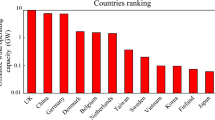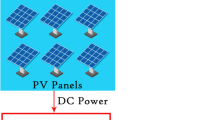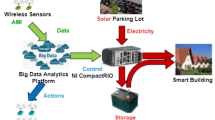Abstract
The solar forecasting is an effective method to enhance the operation of an electrical system for merging a large amount of solar power generation systems and intends to expand a new empirical method to model the prediction uncertainty of the solar irradiance. The proposed model comprises three phases, such as (a) Data Acquisition, (b) Feature Extraction, and (c) Prediction. Initially, benchmark data available from local meteorological organizations are collected that includes the numerical weather forecasting data like temperature, dew point, humidity, visibility, wind speed, and other descriptive information. Once the data is collected, feature extraction is done by first-order and second-order statistical models. First Order Statistics, like mean, median, standard deviation, the maximum value of entire data, and minimum value of entire data, and Second-Order Statistics, like Kurtosis, skewness, correlation, and entropy are extracted as the features. These features are further applied to three machine learning algorithms named Multilayer Perceptron (MLP), Convolutional Neural Network (CNN), and Recurrent Neural Network (RNN). As main novelty of this paper, the number of hidden neurons of all these networks is optimized by a hybrid algorithm merging both the Deer Hunting Optimization Algorithm (DHOA) and Grey Wolf Optimization (GWO), which is named as Grey Updated DHOA (GU-DHOA). The improvement of these networks with the assistance of a hybrid meta-heuristic algorithm will be highly effective for solar irradiance prediction, overcoming the existing machine learning algorithms.






Similar content being viewed by others
Abbreviations
- BIPV:
-
Building Integrated Photo Voltaics
- STC:
-
Solar Thermal Collectors
- GWO:
-
Grey Wolf Optimization
- DHOA:
-
Deer Hunting Optimization Algorithm
- PV:
-
Photo Voltaics
- GHI:
-
Global Horizontal Irradiance
- DNI:
-
Direct Normal Irradiance
- ARIMA:
-
Autoregressive Integrated Moving Average
- ARMAX:
-
Autoregressive Moving Average with Exogenous Inputs
- ARMA:
-
Autoregressive Moving Average
- SVM:
-
Support Vector Machine
- ANN:
-
Artificial Neural Networks
- LSTM:
-
Long Short-Term Memory
- BPNN:
-
Back Propagation Neural Network
- RMSE:
-
Root Mean Square Error
- PDF:
-
Probability Distribution Function
- NWP:
-
Numerical Weather Prediction
- ESS:
-
Energy Storage System
- rRMSE:
-
relative RMSE
- MLP:
-
MultiLayer Perceptron
- GU-DHOA:
-
Grey Updated DHOA
- CNN:
-
Convolutional Neural Network
- MEP:
-
Mean Error Percentage
- RNN:
-
Recurrent Neural Network
- DNN:
-
Deep Neural Network
- MASE:
-
Mean Absolute Scaled Error
- SMAPE:
-
Symmetric Mean Absolute Percentage Error
- GRU:
-
Gate Recurrent Unit
- MSE:
-
Mean Square Error
- MAE:
-
Mean Absolute Error
- NN:
-
Neural Networks
- GA/PSO:
-
Genetic Algorithm/Particle Swarm Optimization
- RBF:
-
Radical Basis Function
- GBRT:
-
Gradient Boosted Regression Trees
- MJ:
-
Mega Joule
- WCO:
-
World Cup Optimization
- IDHOA:
-
Improved Deer Hunting Optimization Algorithm
- ANNs:
-
Artificial Neural Networks
- GSAPSO:
-
Gravitational Search Algorithm and Particle Swarm Optimization
- Q-IWO:
-
Quantum-Invasive Weed Optimization
- SFO:
-
Sunflower Optimization Algorithm
- MR-ESN:
-
Multi-Reservoir Echo State Network
References
Bae KY, Jang HS, Sung DK (2017) Hourly solar irradiance prediction based on support vector machine and its error analysis. IEEE Trans Power Syst 32(2):935–945
Basurto N, Arroyo A, Vega R, Quintián H, Calvo-Rolle JL, Herrero A (2019) A hybrid intelligent system to forecast solar energy production. Comput Electr Eng 78:373–387
Heo Y, Liao W, Xu S (2019) Simplified vector-based model tailored for urban-scale prediction of solar irradiance. Sol Energy 183:566–586
Gueymard CA, Habte A, Sengupta M (2018) Reducing uncertainties in large-scale solar resource data: the impact of aerosols. IEEE J Photovolt 8(6):1732–1737
Plonski PA, Hook JV, Isler V (2016) Environment and solar map construction for solar-powered mobile systems. IEEE Trans Rob 32(1):70–82
Alsadi SY, Nassar YF (2017) Estimation of solar irradiance on solar fields: an analytical approach and experimental results. IEEE Trans Sustain Energy 8(4):1601–1608
Sauer KJ, Roessler T, Hansen CW (2015) Modeling the irradiance and temperature dependence of photovoltaic modules in PVsyst. IEEE J Photovolt 5(1):152–158
Qing X, Niu Y (2018) Hourly day-ahead solar irradiance prediction using weather forecasts by LSTM. Energy 148:461–468
Lorenz E, Hurka J, Heinemann D, Beyer HG (2009) Irradiance forecasting for the power prediction of grid-connected photovoltaic systems. IEEE J Sel Top Appl Earth Obs Remote Sens 2(1):2–10
Dong N, Chang J-F, Wu A-G, Gao Z-K (2020) A novel convolutional neural network framework based solar irradiance prediction method. Int J Electr Power Energy Syst 114:105411
Gustafson WT, Bender G, Leahy LV (2016) Global validation of REST2 incorporated into an operational DNI and GHI irradiance model. In: IEEE 43rd photovoltaic specialists conference (PVSC), Portland, OR, 2016, pp 0947–0952
Lago J, De Brabandere K, De Ridder F, De Schutter B (2018) Short-term forecasting of solar irradiance without local telemetry: a generalized model using satellite data. Sol Energy 173:566–577
Gostein M, Stueve B, Passow K, Panchula A (2016) Evaluating a model to estimate GHI, DNI, and DHI from POA irradiance. In: IEEE 43rd photovoltaic specialists conference (PVSC), Portland, OR, 2016, pp 0943–0946
Chai S, Xu Z, Wong WK (2016) Optimal granule-based pis construction for solar irradiance forecast. IEEE Trans Power Syst 31(4):3332–3333
Weng Y, Wang X, Hua J, Wang H, Kang M, Wang F (2019) Forecasting horticultural products price using ARIMA model and neural network based on a large-scale data set collected by web crawler. IEEE Trans Comput Soc Syst 6(3):547–553
Liu H et al (2017) ARMAX-based transfer function model identification using wide-area measurement for adaptive and coordinated damping control. IEEE Trans Smart Grid 8(3):1105–1115
Li J et al (2019) A stable autoregressive moving average hysteresis model in flexure fast tool servo control. IEEE Trans Autom Sci Eng 16(3):1484–1493
Pelaez SA, Deline C, MacAlpine SM, Marion B, Stein JS, Kostuk RK (2019) Comparison of bifacial solar irradiance model predictions with field validation. IEEE J Photovolt 9(1):82–88
Henney CJ, Hock RA, Schooley AK, Toussaint WA, White SM, Arge CN (2015) Forecasting solar extreme and far ultraviolet irradiance. Space Weather 13(3):141–153
Li X, Jia X, Wang L, Zhao K (2015) On spectral unmixing resolution using extended support vector machines. IEEE Trans Geosci Remote Sens 53(9):4985–4996
Tanaka T, Kawakami W, Kuwabara S, Kobayashi S, Hirano A (2019) Intelligent monitoring of optical fiber bend using artificial neural networks trained with constellation data. IEEE Netw Lett 1(2):60–62
Gibson K, Cole IR, Goss B, Betts TR, Gottschalg R (2017) Compensation of temporal averaging bias in solar irradiance data. IET Renew Power Gener 11(10):1288–1294
Fatemi SA, Kuh A, Fripp M (2018) Parametric methods for probabilistic forecasting of solar irradiance. Renew Energy 129(part A):666–676
Kakimoto M, Endoh Y, Shin H, Ikeda R, Kusaka H (2019) Probabilistic solar irradiance forecasting by conditioning joint probability method and its application to electric power trading. IEEE Trans Sustain Energy 10(2):983–993
Paulescu M, Paulescu E (2019) Short-term forecasting of solar irradiance. Renew Energy 143:985–994
Razmjooy N, Khalilpour M, Ramezani M (2016) A new meta-heuristic optimization algorithm inspired by FIFA World Cup competitions: theory and its application in PID designing for AVR system. J Control Autom Electr Syst 27(4):419–440
Razmjooy N, Ramezani M (2016) Training wavelet neural networks using hybrid particle swarm optimization and gravitational search algorithm for system identification. Int J Mechatron Electr Comput Technol 6(21):2987–2997
Razmjooy N, Ramezani M (2014) An improved quantum evolutionary algorithm based on invasive weed optimization. Indian J Sci Res 4(2):413–422
Yuan Z, Wang W, Wang H, Razmjooy N (2020) A new technique for optimal estimation of the circuit-based PEMFCs using developed sunflower optimization algorithm. Energy Rep 6:662–671
Tian M-W, Yan S-R, Han S-Z, Nojavan S, Jermsittiparsert K, Razmjooy N (2020) New optimal design for a hybrid solar chimney, solid oxide electrolysis and fuel cell based on improved deer hunting optimization algorithm. J Clean Prod 249:119414
Li Q, Zhou W, Ling R, Feng L, Liu K (2020) Multi-reservoir echo state computing for solar irradiance prediction: a fast yet efficient deep learning approach. Appl Soft Comput 95:106481
Kamadinata JO, Ken TL, Suwa T (2019) Sky image-based solar irradiance prediction methodologies using artificial neural networks. Renew Energy 134:837–845
Fernández-Navarro F, Carbonero-Ruz M, Becerra Alonso D, Torres-Jiménez M (2017) Global sensitivity estimates for neural network classifiers. IEEE Trans Neural Netw Learn Syst 28(11):2592–2604
Namatevs I (2017) Deep convolutional neural networks: structure, feature extraction and training. Inf Technol Manag Sci 20:40–47
Li F, Liu M, Alzheimer’s Disease Neuroimaging Initiative (2019) A hybrid convolutional and recurrent neural network for hippocampus analysis in Alzheimer’s disease. J Neurosci Methods 323:108–118
Brammya G, Praveena S, Ninu Preetha NS, Ramya R, Rajakumar BR, Binu D (2019) Deer hunting optimization algorithm: a new nature-inspired meta-heuristic paradigm. Comput J. https://doi.org/10.1093/comjnl/bxy133
Mirjalili S, Mirjalili SM, Lewis A (2014) Grey wolf optimizer. Adv Eng Softw 69:46–61
Pedersen MEH, Chipperfield AJ (2010) Simplifying particle swarm optimization. Appl Soft Comput 10(2):618–628
Mirjalili S, Lewis A (2016) The whale optimization algorithm. Adv Eng Softw 95:51–67
Author information
Authors and Affiliations
Corresponding author
Additional information
Publisher's Note
Springer Nature remains neutral with regard to jurisdictional claims in published maps and institutional affiliations.
Rights and permissions
About this article
Cite this article
Vaisakh, T., Jayabarathi, R. Analysis on intelligent machine learning enabled with meta-heuristic algorithms for solar irradiance prediction. Evol. Intel. 15, 235–254 (2022). https://doi.org/10.1007/s12065-020-00505-6
Received:
Revised:
Accepted:
Published:
Issue Date:
DOI: https://doi.org/10.1007/s12065-020-00505-6




